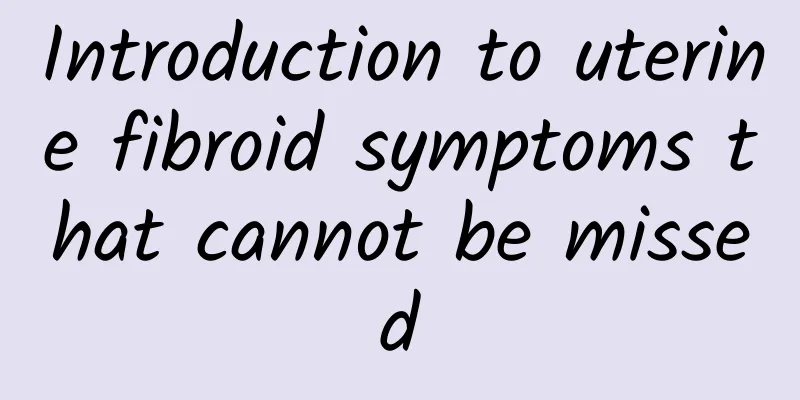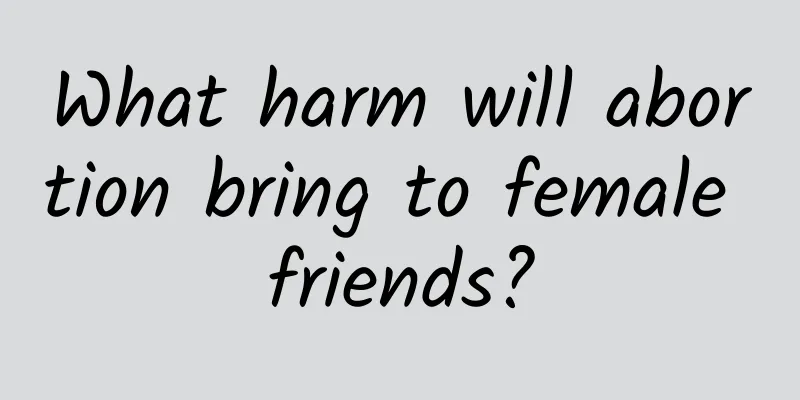Introduction to uterine fibroid symptoms that cannot be missed

|
What are the symptoms of uterine fibroids? Uterine fibroids are also called uterine leiomyoma, but the symptoms of uterine fibroids are not obvious. If the pedicle is twisted or other conditions occur, it may cause pain, which is common in multiple uterine fibroids. So, what are the symptoms of uterine fibroids? 1. Pain: Symptoms of uterine fibroids can cause blood stasis, or compress nerves, or pedicled submucosal fibroids can stimulate uterine contraction, which is discharged from the uterine cavity, causing the cervical canal to widen and cause pain; or fibroid necrosis and infection can cause pelvic inflammatory disease, adhesion, traction, etc. Acute and severe abdominal pain can also occur when the pedicle of the uterine subserosal fibroid is twisted or the uterus is axially twisted. Large subserosal fibroids grow into the broad ligament, which can not only compress nerves and blood vessels to cause pain, but also compress the ureter to cause ureteral or renal hydrops and cause low back pain. Those with severe and progressive dysmenorrhea due to uterine fibroids are often caused by uterine fibroids complicated by adenomyosis or endometriosis. 2. Uterine bleeding: occurs in half or more of the patients. Symptoms of uterine fibroids are mostly excessive menstrual flow, prolonged menstruation or shortened menstrual cycle, accounting for about 2/3; continuous or irregular bleeding accounts for 1/3. Bleeding is mainly caused by intramural fibroids and submucosal fibroids. Intramural fibroids often have periodic bleeding, while submucosal fibroids often show irregular bleeding. Subserosal fibroids rarely cause uterine bleeding. 3. Abdominal mass: Symptoms of uterine fibroids are often obvious in the early morning when the bladder is full and the uterus is empty. Because the uterus and fibroids are pushed upward, it is easy for the patient to touch them. If the uterus is larger than 4-5 months of pregnancy, it can also be touched when the bladder is not full. Symptoms of uterine fibroids are generally located in the middle of the lower abdomen, and a few may be located on one side of the lower abdomen, with a hard texture or uneven feeling. Larger ones are more likely to be degenerated, softer and smoother. Most of them grow slowly. The above is the knowledge about the symptoms of uterine fibroids introduced by uterine fibroids experts. I wish you a speedy recovery. If you have any questions about the symptoms of uterine fibroids, please consult our online experts, who will answer the symptoms of uterine fibroids. Uterine fibroids http://www..com.cn/fuke/zgjl/ |
<<: What are the common symptoms of ovarian cysts?
>>: Five points to determine whether you have uterine fibroids symptoms
Recommend
Why do I only have my period once every two months?
Why do I only have my period once every two month...
How to care for patients with amenorrhea
In fact, amenorrhea is a very common and serious ...
Why do I only have my period once every March or April?
Menstruation only once every 3 to 4 months is usu...
What is vulvovaginitis?
What is vaginitis? This is a concern for everyone...
What are the main diagnostic criteria for irregular menstruation?
What are the main diagnostic criteria for irregul...
What harm does dysmenorrhea bring to women?
Many female friends think that dysmenorrhea is a ...
How can women prevent cervical erosion from becoming cancerous? Five aspects must be followed to prevent cervical erosion
Cervical erosion is a very common gynecological d...
What are the common clinical manifestations of endometrial tuberculosis?
Endometrial tuberculosis refers to the appearance...
Cost of curing hyperprolactinemia
How much does it cost to cure hyperprolactinemia?...
Obesity in children may lead to complications of cardiovascular disease and fatty liver! Pediatricians teach 9 ways to beat childhood obesity
According to a survey by the Ministry of Educatio...
How to regulate menstrual irregularities during menopause? How to regulate menstrual irregularities?
Women in menopause are also prone to irregular me...
What are the causes of vaginitis? Can I get vaginitis even if I don’t have sex?
Vaginitis is a common disease in the female vagin...
What are the Chinese patent medicines for treating uterine fibroids?
What are the Chinese patent medicines for treatin...
Menopausal women can use Chinese medicine fumigation to treat vulvar leukoplakia
The menopause and post-menopause period is a high...
Why does cervicitis lead to infertility? 4 must-check items for diagnosing cervicitis
Cervicitis is usually diagnosed through secretion...









